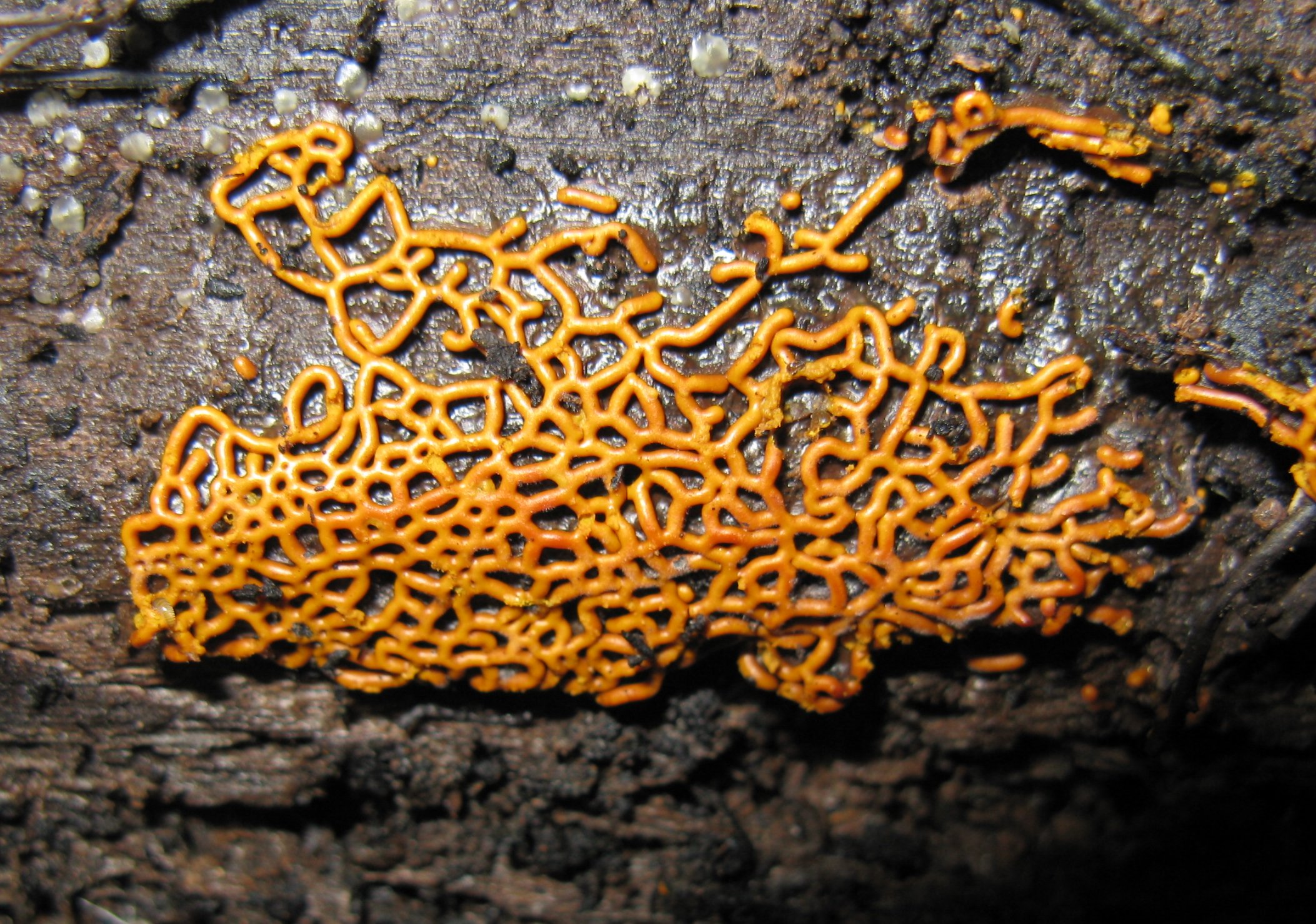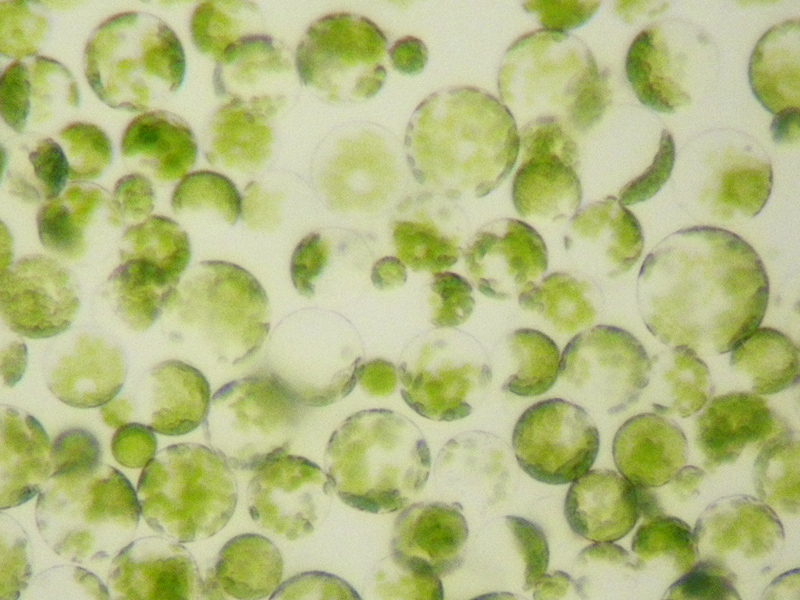|
Plasmodial
A plasmodium is a living structure of cytoplasm that contains many nuclei, rather than being divided into individual cells each with a single nucleus. Plasmodia are best known from slime molds, but are also found in parasitic Myxosporea, and some algae such as the Chlorarachniophyta. Structure A plasmodium is an amoeboid, multinucleate, and naked mass of cytoplasm that contains many diploid nuclei. The resulting structure, a coenocyte, is created by many nuclear divisions without the process of cytokinesis, which in other organisms pulls newlydivided cells apart. In some cases, the resulting structure is a syncytium, created by the fusion of cells after division. Under suitable conditions, plasmodia differentiates and forms fruiting bodies bearing spores at their tips. Taxonomic distribution The term plasmodium, introduced by Leon Cienkowski, usually refers to the feeding stage of slime molds; these are macroscopic mycetozoans. The multinucleate developmental stages of som ... [...More Info...] [...Related Items...] OR: [Wikipedia] [Google] [Baidu] |
Slime Mold
Slime mold or slime mould is an informal name given to several kinds of unrelated eukaryotic organisms with a life cycle that includes a free-living single-celled stage and the formation of spores. Spores are often produced in macroscopic multicellular or multinucleate fruiting bodies which may be formed through aggregation or fusion. Slime molds were formerly classified as fungi but are no longer considered part of that kingdom. Although not forming a single monophyletic clade, they are grouped within the paraphyletic group Protista. More than 900 species of slime mold occur globally. Their common name refers to part of some of these organisms' life cycles where they can appear as gelatinous "slime". This is mostly seen with the Myxogastria, which are the only macroscopic slime molds. Most slime molds are smaller than a few centimetres, but some species may reach sizes up to several square metres and masses up to 20 kilograms. They feed on microorganisms that live in ... [...More Info...] [...Related Items...] OR: [Wikipedia] [Google] [Baidu] |
Hemitrichia Serpula 57955
''Hemitrichia'' is a genus of slime molds, of the family Trichiidae, found within the order Trichiida. It was first described by Josef Rostafinksi in 1873 and remains a well-defined genus of the slime molds. ''Hemitrichia'' species exhibit either plasmodiocarp or sporangium fruiting bodies, both of which are well-known and recognizable slime molds seen on multiple continents. The genus includes ''Hemtrichia serpula'', known as the pretzel slime mold, an iconic and widespread species that has been used to examine speciation in slime molds. Etymology ''Hemi'' comes directly from the Greek prefix hemi, meaning “half”. ''Trichia'' is combination of the Greek trichios, which refers to hair or hair-like structure and –ia, referring to a condition, leading to –''trichia'' being the condition of having hair. ''Hemitrichia'' therefore refers to the condition of partially having hair. Josef Rostafinkski described ''Hemitrichia'' in the family Trichiaceae, along with another genera ... [...More Info...] [...Related Items...] OR: [Wikipedia] [Google] [Baidu] |
Plasmodiophorid
The Phytomyxea are a class of parasites that are cosmopolitan, obligate biotrophic protist parasites of plants, diatoms, oomycetes and brown algae. They are divided into the orders Plasmodiophorida ( ICZN, or Plasmodiophoromycota, ICBN) and Phagomyxida. Plasmodiophorids are best known as pathogens or vectors for viruses of arable crops (e.g. club root in Brassicaceae, powdery scab in potatoes, and rhizomania in beets, especially sugar beets and some spinaches). Life cycle They typically develop within plant cells, causing the infected tissue to grow into a gall or scab. Important diseases caused by phytomyxeans include club root in cabbage and its relatives, and powdery scab in potatoes. These are caused by species of ''Plasmodiophora'' and ''Spongospora'', respectively.Agrios, George N. (2005). ''Plant Pathology''. 5th ed. Academic Presslink The vegetative form is a multinucleate cell, called a plasmodium. This ultimately divides to form new spores, which are released ... [...More Info...] [...Related Items...] OR: [Wikipedia] [Google] [Baidu] |
Syncytia
A syncytium (; plural syncytia; from Greek: σύν ''syn'' "together" and κύτος ''kytos'' "box, i.e. cell") or symplasm is a multinucleate cell which can result from multiple cell fusions of uninuclear cells (i.e., cells with a single nucleus), in contrast to a coenocyte, which can result from multiple nuclear divisions without accompanying cytokinesis. The muscle cell that makes up animal skeletal muscle is a classic example of a syncytium cell. The term may also refer to cells interconnected by specialized membranes with gap junctions, as seen in the heart muscle cells and certain smooth muscle cells, which are synchronized electrically in an action potential. The field of embryogenesis uses the word ''syncytium'' to refer to the coenocytic blastoderm embryos of invertebrates, such as ''Drosophila melanogaster''. Physiological examples Protists In protists, syncytia can be found in some rhizarians (e.g., chlorarachniophytes, plasmodiophorids, haplosporidians) and acellular ... [...More Info...] [...Related Items...] OR: [Wikipedia] [Google] [Baidu] |
Syncytium
A syncytium (; plural syncytia; from Greek: σύν ''syn'' "together" and κύτος ''kytos'' "box, i.e. cell") or symplasm is a multinucleate cell which can result from multiple cell fusions of uninuclear cells (i.e., cells with a single nucleus), in contrast to a coenocyte, which can result from multiple nuclear divisions without accompanying cytokinesis. The muscle cell that makes up animal skeletal muscle is a classic example of a syncytium cell. The term may also refer to cells interconnected by specialized membranes with gap junctions, as seen in the heart muscle cells and certain smooth muscle cells, which are synchronized electrically in an action potential. The field of embryogenesis uses the word ''syncytium'' to refer to the coenocytic blastoderm embryos of invertebrates, such as ''Drosophila melanogaster''. Physiological examples Protists In protists, syncytia can be found in some rhizarians (e.g., chlorarachniophytes, plasmodiophorids, haplosporidians) and acellula ... [...More Info...] [...Related Items...] OR: [Wikipedia] [Google] [Baidu] |
Multinucleate
Multinucleate cells (also known as multinucleated or polynuclear cells) are eukaryotic cells that have more than one nucleus per cell, i.e., multiple nuclei share one common cytoplasm. Mitosis in multinucleate cells can occur either in a coordinated, synchronous manner where all nuclei divide simultaneously or asynchronously where individual nuclei divide independently in time and space. Certain organisms may have a multinuclear stage of their life cycle. For example, slime molds have a vegetative, multinucleate life stage called a plasmodium. Although not normally viewed as a case of multinucleation, plant cells share a common cytoplasm by plasmodesmata, and most cells in animal tissues are in communication with their neighbors via gap junctions. Multinucleate cells, depending on the mechanism by which they are formed, can be divided into "syncytia" (formed by cell fusion) or "coenocytes" (formed by nuclear division not being followed by cytokinesis). A number of dinoflagellat ... [...More Info...] [...Related Items...] OR: [Wikipedia] [Google] [Baidu] |
Mycetozoa
Mycetozoa is a polyphyletic grouping of slime molds. It was originally thought to be a monophyletic clade, but recently it was discovered that protostelia are a polyphyletic group within Conosa. Classification It can be divided into dictyostelid, myxogastrid, and protostelid groups. The mycetozoan groups all fit into the unikont supergroup Amoebozoa, whereas most other slime molds fit into various bikont groups ( fonticulids are opisthokonts). Utility in research The dictyostelids are used as examples of cell communication and differentiation, and may provide insights into how multicellular organisms develop. ''Physarum polycephalum'' are useful for studying cytoplasmic streaming. They have also been used to study the biochemical events that surround mitosis, since all of the nuclei in a medium-sized plasmodium divide in synchrony. It has been observed that they can find their way through mazes by spreading out and choosing the shortest path, an interesting example of informa ... [...More Info...] [...Related Items...] OR: [Wikipedia] [Google] [Baidu] |
Microsporidia
Microsporidia are a group of spore-forming unicellular parasites. These spores contain an extrusion apparatus that has a coiled polar tube ending in an anchoring disc at the apical part of the spore. They were once considered protozoans or protists, but are now known to be fungi, or a sister group to fungi. These fungal microbes are obligate eukaryotic parasites that use a unique mechanism to infect host cells. They have recently been discovered in a 2017 Cornell study to infect Coleoptera on a large scale. So far, about 1500 of the probably more than one million species are named. Microsporidia are restricted to animal hosts, and all major groups of animals host microsporidia. Most infect insects, but they are also responsible for common diseases of crustaceans and fish. The named species of microsporidia usually infect one host species or a group of closely related taxa. Approximately 10 percent of the species are parasites of vertebrates —several species, most of which are ... [...More Info...] [...Related Items...] OR: [Wikipedia] [Google] [Baidu] |
Cercozoa
Cercozoa is a phylum of diverse single-celled eukaryotes. They lack shared morphological characteristics at the microscopic level, and are instead defined by molecular phylogenies of rRNA and actin or polyubiquitin. They were the first major eukaryotic group to be recognized mainly through molecular phylogenies. They are the natural predators of many species of microbacteria and Archea. They are closely related to the phylum Retaria, comprising amoeboids that usually have complex shells, and together form a supergroup called Rhizaria. Characteristics The group includes most amoeboids and flagellates that feed by means of filose pseudopods. These may be restricted to part of the cell surface, but there is never a true cytostome or mouth as found in many other protozoa. They show a variety of forms and have proven difficult to define in terms of structural characteristics, although their unity is strongly supported by phylogenetic studies. Diversity Some cercozoans are grouped ... [...More Info...] [...Related Items...] OR: [Wikipedia] [Google] [Baidu] |
Protoplast
Protoplast (), is a biological term coined by Hanstein in 1880 to refer to the entire cell, excluding the cell wall. Protoplasts can be generated by stripping the cell wall from plant, bacterial, or fungal cells by mechanical, chemical or enzymatic means. Protoplasts differ from spheroplasts in that their cell wall has been completely removed. Spheroplasts retain part of their cell wall. In the case of Gram-negative bacterial spheroplasts, for example, the peptidoglycan component of the cell wall has been removed but the outer membrane component has not. Enzymes for the preparation of protoplasts Cell walls are made of a variety of polysaccharides. Protoplasts can be made by degrading cell walls with a mixture of the appropriate polysaccharide-degrading enzymes: During and subsequent to digestion of the cell wall, the protoplast becomes very sensitive to osmotic stress. This means cell wall digestion and protoplast storage must be done in an isotonic solution to prevent ... [...More Info...] [...Related Items...] OR: [Wikipedia] [Google] [Baidu] |
Rhizaria
The Rhizaria are an ill-defined but species-rich supergroup of mostly unicellular eukaryotes. Except for the Chlorarachniophytes and three species in the genus Paulinella in the phylum Cercozoa, they are all non-photosynthethic, but many foraminifera and radiolaria have a symbiotic relationship with unicellular algae. A multicellular form, ''Guttulinopsis vulgaris'', a cellular slime mold, has also been described. This group was used by Cavalier-Smith in 2002, although the term "Rhizaria" had been long used for clades within the currently recognized taxon. Being described mainly from rDNA sequences, they vary considerably in form, having no clear morphological distinctive characters (synapomorphies), but for the most part they are amoeboids with filose, reticulose, or microtubule-supported pseudopods. In the absence of an apomorphy, the group is ill-defined, and its composition has been very fluid. Some Rhizaria possess mineral exoskeleton (thecae or loricas), which is in differ ... [...More Info...] [...Related Items...] OR: [Wikipedia] [Google] [Baidu] |
Cnidospora
Cnidospora is a wikt:Defunct, defunct subphylum of microscopic spore-forming parasites in the defunct phylum Protozoa. The subphylum was divided into two class (biology), classes, the Myxosporea, Myxosporidea (now classified as higher-animals, i.e. Metazoa) and the Microsporidia, Microsporidea (now classified as fungi). References {{wikispecies Obsolete eukaryote taxa Opisthokont subphyla ... [...More Info...] [...Related Items...] OR: [Wikipedia] [Google] [Baidu] |



